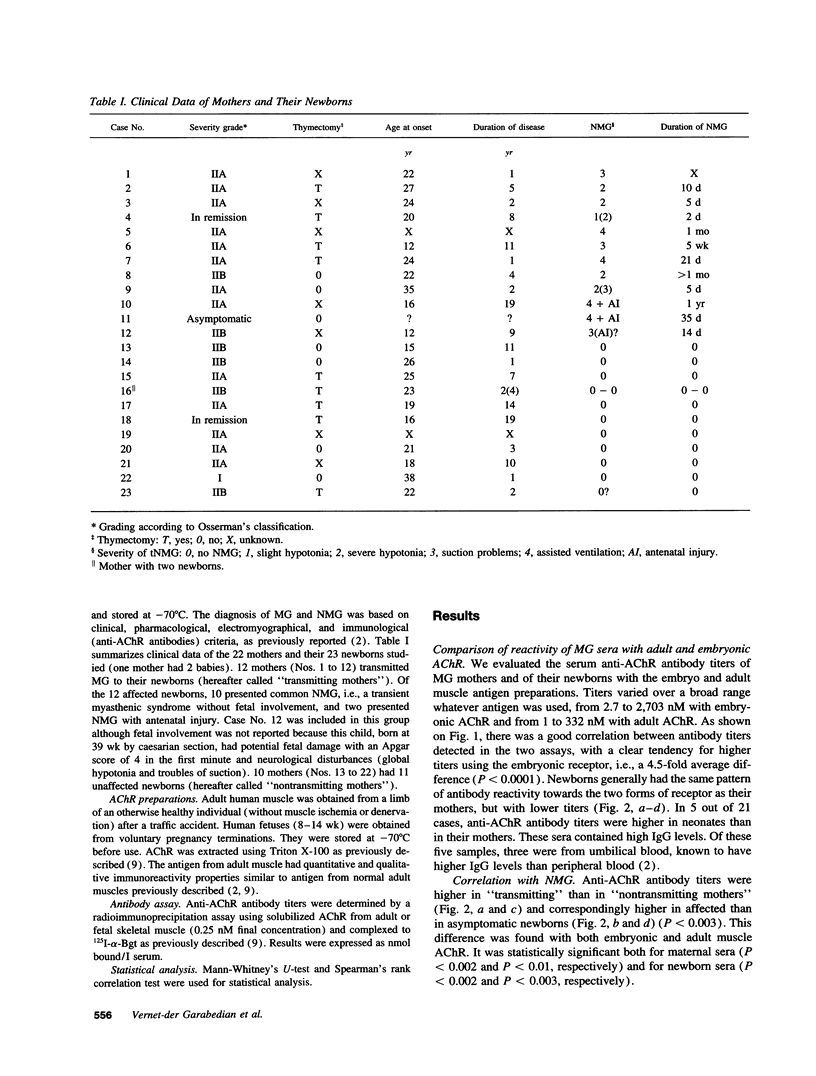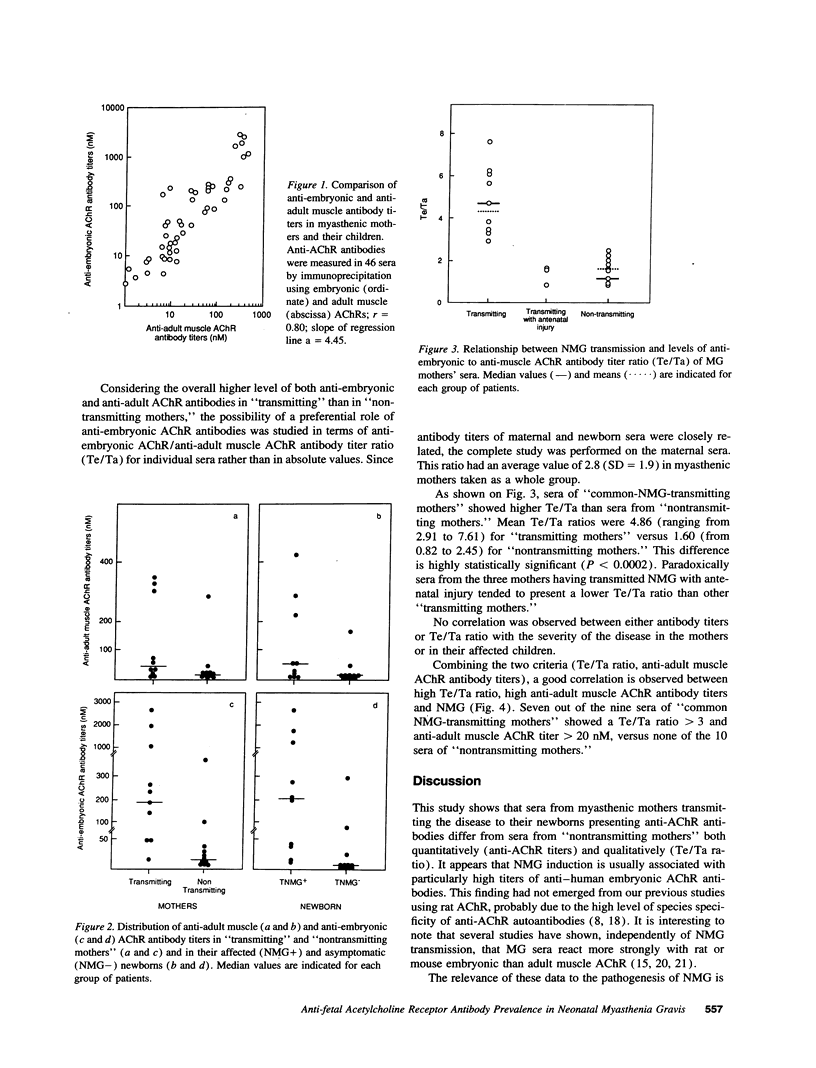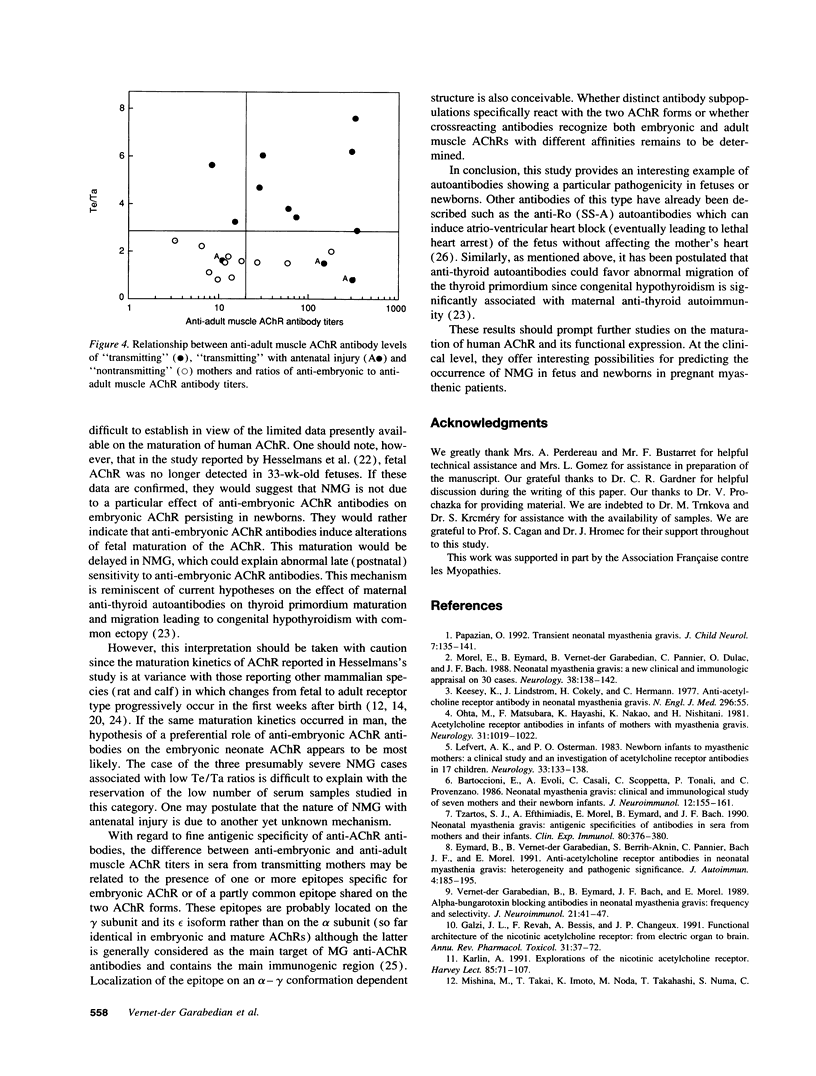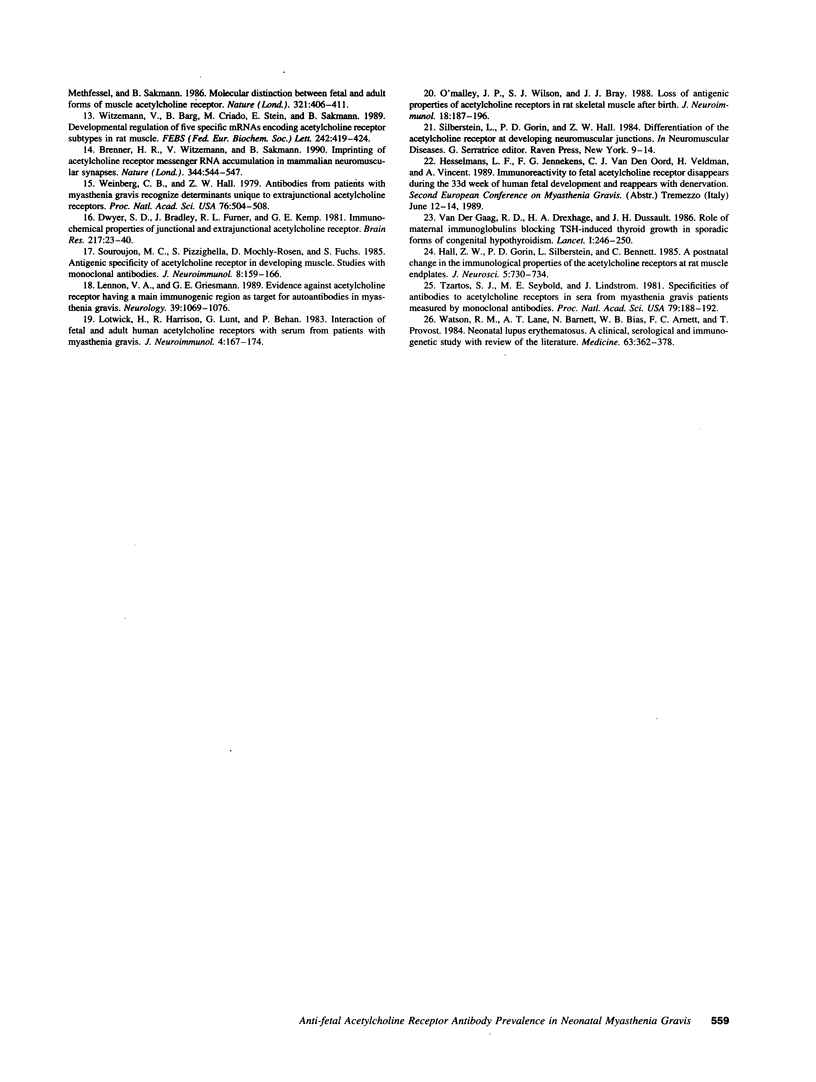Abstract
The specificities of autoantibodies directed against the acetylcholine receptor (AChR) for embryonic and adult muscle AChR were studied in 22 mothers with myasthenia gravis (MG) and in their newborns using human fetus and normal adult muscle AChR preparations. 12 mothers had transmitted MG to their neonates with, in three cases, antenatal injury. A clear correlation was found between occurrence of neonatal MG (NMG) and the high overall level of anti-AChR antibodies (embryonic or adult muscle AChR). However, a strong correlation was also found between occurrence of NMG and the ratio of anti-embryonic AChR to anti-adult muscle (Te/Ta) AChR antibodies (P < 0.0002). Taken together, these data suggest that autoantibodies directed against the embryonic form of the AChR could play a predominant role in the pathogenesis of NMG. Paradoxically, the three cases with antenatal injury presumably the most severe form of NMG, were not associated with high Te/Ta. At the clinical level, these observations could prove helpful in the prediction of transmission of NMG.
Full text
PDF




Selected References
These references are in PubMed. This may not be the complete list of references from this article.
- Bartoccioni E., Evoli A., Casali C., Scoppetta C., Tonali P., Provenzano C. Neonatal myasthenia gravis: clinical and immunological study of seven mothers and their newborn infants. J Neuroimmunol. 1986 Aug;12(2):155–161. doi: 10.1016/0165-5728(86)90028-7. [DOI] [PubMed] [Google Scholar]
- Brenner H. R., Witzemann V., Sakmann B. Imprinting of acetylcholine receptor messenger RNA accumulation in mammalian neuromuscular synapses. Nature. 1990 Apr 5;344(6266):544–547. doi: 10.1038/344544a0. [DOI] [PubMed] [Google Scholar]
- Dwyer D. S., Bradley R. J., Furner R. L., Kemp G. E. Immunochemical properties of junctional and extrajunctional acetylcholine receptor. Brain Res. 1981 Jul 27;217(1):23–40. doi: 10.1016/0006-8993(81)90182-7. [DOI] [PubMed] [Google Scholar]
- Eymard B., Vernet-der Garabedian B., Berrih-Aknin S., Pannier C., Bach J. F., Morel E. Anti-acetylcholine receptor antibodies in neonatal myasthenia gravis: heterogeneity and pathogenic significance. J Autoimmun. 1991 Apr;4(2):185–195. doi: 10.1016/0896-8411(91)90017-7. [DOI] [PubMed] [Google Scholar]
- Galzi J. L., Revah F., Bessis A., Changeux J. P. Functional architecture of the nicotinic acetylcholine receptor: from electric organ to brain. Annu Rev Pharmacol Toxicol. 1991;31:37–72. doi: 10.1146/annurev.pa.31.040191.000345. [DOI] [PubMed] [Google Scholar]
- Hall Z. W., Gorin P. D., Silberstein L., Bennett C. A postnatal change in the immunological properties of the acetylcholine receptor at rat muscle endplates. J Neurosci. 1985 Mar;5(3):730–734. doi: 10.1523/JNEUROSCI.05-03-00730.1985. [DOI] [PMC free article] [PubMed] [Google Scholar]
- Karlin A. Explorations of the nicotinic acetylcholine receptor. Harvey Lect. 1989;85:71–107. [PubMed] [Google Scholar]
- Keesey J., Lindstrom J., Cokely H. Anti-acetylcholine receptor antibody in neonatal myasthenia gravis. N Engl J Med. 1977 Jan 6;296(1):55–55. doi: 10.1056/NEJM197701062960125. [DOI] [PubMed] [Google Scholar]
- Lefvert A. K., Osterman P. O. Newborn infants to myasthenic mothers: a clinical study and an investigation of acetylcholine receptor antibodies in 17 children. Neurology. 1983 Feb;33(2):133–138. doi: 10.1212/wnl.33.2.133. [DOI] [PubMed] [Google Scholar]
- Lennon V. A., Griesmann G. E. Evidence against acetylcholine receptor having a main immunogenic region as target for autoantibodies in myasthenia gravis. Neurology. 1989 Aug;39(8):1069–1076. doi: 10.1212/wnl.39.8.1069. [DOI] [PubMed] [Google Scholar]
- Lotwick H., Harrison R., Lunt G., Behan P. Interaction of foetal and adult human acetylcholine receptors with serum from patients with myasthenia gravis. J Neuroimmunol. 1983 Jun;4(3):167–174. doi: 10.1016/0165-5728(83)90033-4. [DOI] [PubMed] [Google Scholar]
- Mishina M., Takai T., Imoto K., Noda M., Takahashi T., Numa S., Methfessel C., Sakmann B. Molecular distinction between fetal and adult forms of muscle acetylcholine receptor. Nature. 1986 May 22;321(6068):406–411. doi: 10.1038/321406a0. [DOI] [PubMed] [Google Scholar]
- Morel E., Eymard B., Vernet-der Garabedian B., Pannier C., Dulac O., Bach J. F. Neonatal myasthenia gravis: a new clinical and immunologic appraisal on 30 cases. Neurology. 1988 Jan;38(1):138–142. doi: 10.1212/wnl.38.1.138. [DOI] [PubMed] [Google Scholar]
- O'Malley J. P., Wilson S. J., Bray J. J. Loss of antigenic properties of acetylcholine receptors in rat skeletal muscle after birth. J Neuroimmunol. 1988 Jun;18(3):187–196. doi: 10.1016/0165-5728(88)90096-3. [DOI] [PubMed] [Google Scholar]
- Ohta M., Matsubara F., Hayashi K., Nakao K., Nishitani H. Acetylcholine receptor antibodies in infants of mothers with myasthenia gravis. Neurology. 1981 Aug;31(8):1019–1022. doi: 10.1212/wnl.31.8.1019. [DOI] [PubMed] [Google Scholar]
- Papazian O. Transient neonatal myasthenia gravis. J Child Neurol. 1992 Apr;7(2):135–141. doi: 10.1177/088307389200700202. [DOI] [PubMed] [Google Scholar]
- Souroujon M. C., Pizzighella S., Mochly-Rosen D., Fuchs S. Antigenic specificity of acetylcholine receptor in developing muscle. Studies with monoclonal antibodies. J Neuroimmunol. 1985 May;8(2-3):159–166. doi: 10.1016/s0165-5728(85)80056-4. [DOI] [PubMed] [Google Scholar]
- Tzartos S. J., Efthimiadis A., Morel E., Eymard B., Bach J. F. Neonatal myasthenia gravis: antigenic specificities of antibodies in sera from mothers and their infants. Clin Exp Immunol. 1990 Jun;80(3):376–380. doi: 10.1111/j.1365-2249.1990.tb03296.x. [DOI] [PMC free article] [PubMed] [Google Scholar]
- Tzartos S. J., Seybold M. E., Lindstrom J. M. Specificities of antibodies to acetylcholine receptors in sera from myasthenia gravis patients measured by monoclonal antibodies. Proc Natl Acad Sci U S A. 1982 Jan;79(1):188–192. doi: 10.1073/pnas.79.1.188. [DOI] [PMC free article] [PubMed] [Google Scholar]
- Vernet-der Garabedian B., Eymard B., Bach J. F., Morel E. Alpha-bungarotoxin blocking antibodies in neonatal myasthenia gravis: frequency and selectivity. J Neuroimmunol. 1989 Jan;21(1):41–47. doi: 10.1016/0165-5728(89)90157-4. [DOI] [PubMed] [Google Scholar]
- Watson R. M., Lane A. T., Barnett N. K., Bias W. B., Arnett F. C., Provost T. T. Neonatal lupus erythematosus. A clinical, serological and immunogenetic study with review of the literature. Medicine (Baltimore) 1984 Nov;63(6):362–378. [PubMed] [Google Scholar]
- Weinberg C. B., Hall Z. W. Antibodies from patients with myasthenia gravis recognize determinants unique to extrajunctional acetylcholine receptors. Proc Natl Acad Sci U S A. 1979 Jan;76(1):504–508. doi: 10.1073/pnas.76.1.504. [DOI] [PMC free article] [PubMed] [Google Scholar]
- Witzemann V., Barg B., Criado M., Stein E., Sakmann B. Developmental regulation of five subunit specific mRNAs encoding acetylcholine receptor subtypes in rat muscle. FEBS Lett. 1989 Jan 2;242(2):419–424. doi: 10.1016/0014-5793(89)80514-9. [DOI] [PubMed] [Google Scholar]
- van der Gaag R. D., Drexhage H. A., Dussault J. H. Role of maternal immunoglobulins blocking TSH-induced thyroid growth in sporadic forms of congenital hypothyroidism. Lancet. 1985 Feb 2;1(8423):246–250. doi: 10.1016/s0140-6736(85)91028-1. [DOI] [PubMed] [Google Scholar]


